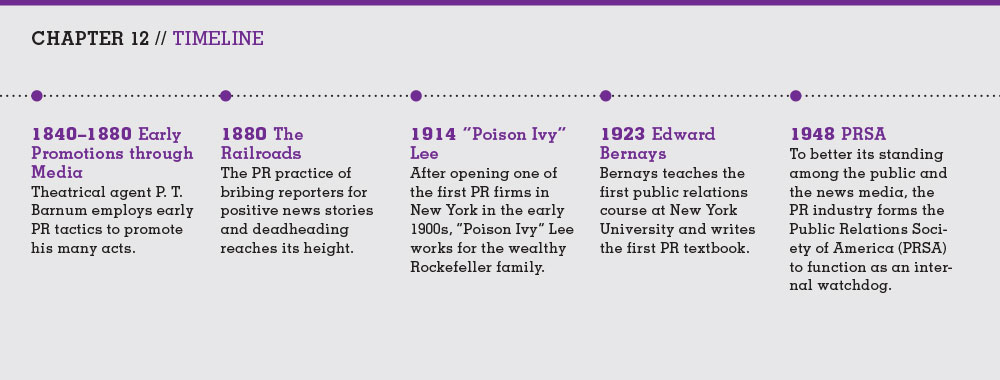Chapter Introduction
12
Public Relations and Framing the Message

About a hundred years ago, in the second decade of the twentieth century, media stardom emerged as both the subject of public fascination and a human resource to be exploited by the movie business. Interest in the private lives of stars spawned gossip columns and fan magazines that usually relayed information provided by press agents employed by the stars’ studios. Today, Hollywood’s public relations (PR) machinery continues to construct images, often emphasizing the ordinary aspects of its extraordinary people; stars are depicted as regular folks who enjoy sports, love their children and pets, and go grocery shopping. However, even the most visible stars have traditionally been insulated from direct contact with their adoring fans by armies of bodyguards, publicists, and other industry functionaries.
For many popular performers, the layers of PR professionals protecting them from both their fans and themselves have been peeled away by the social networking site Twitter. Twitter, which began in 2006, is a “micro-blogging” site where users can post status updates and follow feeds that display the updates of friends, acquaintances, and, increasingly, celebrities—a converged form of mass communication that can be used to reach dozens of friends or thousands (or millions) of fans. As of early 2015, Katy Perry had the most followers (over 72 million), followed by Justin Bieber (65 million), President Barack Obama (62 million), Taylor Swift (60 million), and video site YouTube (53 million).1 These enormous followings allow stars and politicians to engage in public relations beyond magazines like Us Weekly or gossip shows like Entertainment Tonight—or, in the case of President Obama, beyond traditional news outlets. For celebrities and politicians, this can allow them to share messages directly with their followers.
In some cases, celebrities themselves tweet out to their fans, bypassing the usual layers of handlers and media professionals and creating the illusion of personal connection. But others, perhaps fearing an embarrassing mistake, hire public relations firms to run their Twitter and other social media accounts, which of course risks turning off fans who want to hear from celebrities directly, not one of their employees. The experience of actor Ashton Kutcher gives an idea of the public relations paradox celebrities can face on Twitter. Kutcher was an early adopter of Twitter, and the spontaneous and unfiltered style of his tweets resonated with fans. Soon he had a huge Twitter following, bigger than many more-prominent stars. But the tweets that helped him get followers became a liability when he reacted to the firing of Joe Paterno, the head football coach at Penn State. He lambasted the decision without fully understanding that it was connected to the coach’s implication in the cover-up of a child sex-abuse scandal. Kutcher later deleted the tweet, but not before prompting a flood of responses that attacked the star for supporting the disgraced football legend. The event so rattled Kutcher that he issued a statement announcing that he was turning the management of his account over to his PR team at Katalyst Media as a “secondary editorial measure.”2
Clearly, much of the popularity of stars like Katy Perry, Taylor Swift, and Ashton Kutcher has been cultivated and nurtured by Twitter-based connections with their publics. But it seems likely that this newfound interactivity will actually increase the need for PR professionals, be it for formal approvals—like those of Kutcher’s media team—or for less regulated consulting for celebrities who want to keep control of their feed. With media platforms converging and stars becoming more accessible than ever, public relations work will continue to expand beyond traditional events, comments, and press releases.
AS THE STORY OF CELEBRITY TWITTER ACCOUNTS REVEALS, the field of public relations continues to grow and change with the media industries it depends on. An effective public relations effort involves numerous activities, including shaping the public image of a product (or a person or an organization), establishing or restoring communication between consumers and companies, and promoting particular individuals or organizations. Broadly defined, public relations refers to the total communication strategy conducted by a person, a government, or an organization attempting to reach an audience and persuade it to adopt a point of view.3 Or, in the brief definition offered by the Public Relations Society of America (PRSA), “Public relations helps an organization and its publics adapt mutually to each other.”
Although public relations may sound very similar to advertising, which also seeks to persuade audiences, it differs in important respects. Advertising uses discrete, simple, and fixed messages (“Our appliance is the most efficient and affordable”), transmitted directly to the public through the purchase of ads for specific products or services. Whereas advertising focuses mainly on sales, public relations develops or reshapes an image for a person, an organization, a product, a service, or an issue to make it more marketable, popular, important, compelling, or accessible, among other desired outcomes. In doing so, public relations creates more complex messages that may evolve over time (for example, a political campaign, or a long-term strategy to dispel unfavorable reports about “fatty processed foods”). PR may be transmitted to the public indirectly, often through articles and reports in the news media. Finally, public relations messages often reflect larger trends and ideas that are percolating through society—such as the notion that it is good to recycle, or that smoking is bad for you. Even broad ideas like “liberty” or “fairness” often take on connotations based on public relations efforts. PR thus shapes and is shaped by what is going on in society at large.
Since its inception, PR has exerted a huge influence on American society and culture. For example, after the Industrial Revolution, when people began purchasing (rather than making) many of the goods they needed, manufacturers used PR to emphasize how various industries benefited consumers. By helping to drive economic activity, the public relations profession thus contributed to an improvement in standards of living in the United States. PR also set the tone for the corporate image-building that characterized the twentieth century—and for the debates over today’s environmental, energy, labor, and other public policy issues. However, PR’s most significant impact is probably on the political process: Politicians and organizations hire PR professionals to shape their image in the media, which influences how people vote. No matter what issue you care about, there is undoubtedly someone doing PR on its behalf, on all sides.
Today, there are more than twenty-nine hundred PR firms worldwide, including nineteen hundred in the United States. Many organizations also have in-house departments devoted to PR. Moreover, since the 1980s, the formal study of public relations has grown significantly at colleges and universities. By 2015, the Public Relations Student Society of America (PRSSA) boasted more than eleven thousand student members and more than three hundred chapters in colleges and universities.
In this chapter, we examine the workings and the impact of public relations in more detail by:
looking at the early days of public relations, including the emergence of press agents and the birth of modern PR
considering how the PR profession has evolved in terms of the structure of public relations firms and the functions that PR practitioners perform (such as formulating messages about their clients and conveying those messages to the public)
exploring the tensions that have arisen between public relations professionals and the press, and the causes behind those tensions
considering the role PR plays in our democratic society by focusing on the impact of public relations on the political process in particular
CHAPTER 12 // TIMELINE
1840–1880 Early Promotions through Media
Theatrical agent P. T. Barnum employs early PR tactics to promote his many acts.
1880 The Railroads
The PR practice of bribing reporters for positive news stories and deadheading reaches its height.
1914 “Poison Ivy” Lee
After opening one of the first PR firms in New York in the early 1900s, “Poison Ivy” Lee works for the wealthy Rockefeller family.
1923 Edward Bernays
Bernays teaches the first public relations course at New York University and writes the first PR textbook.
1948 PRSA
To better its standing among the public and the news media, the PR industry forms the Public Relations Society of America (PRSA) to function as an internal watchdog.
1982 Tylenol Scare
After it is determined that Tylenol capsules have been laced with cyanide, Johnson & Johnson responds with rapid and ethical PR crisis management, saving the Tylenol brand.
1989 Exxon Valdez Disaster
Exxon’s initial denials of responsibility and slow response to the Exxon Valdez oil spill severely damage its reputation.
1996 Walmart and Sweatshop Labor
Human-rights groups bring attention to sweatshop labor when they expose the production conditions of Walmart’s Kathie Lee Gifford clothing line.
2005 Video News Releases (VNRs) draw FCC action
Responding to citizen pressure, the FCC mandates that the source of a video news release (VNR) must be clearly disclosed when broadcast.

Click on the timeline above to see the full, expanded version.